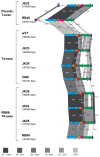A Quest of Great Importance-Developing a Broad Spectrum Escherichia coli Phage Collection
- PMID: 31561510
- PMCID: PMC6832132
- DOI: 10.3390/v11100899
A Quest of Great Importance-Developing a Broad Spectrum Escherichia coli Phage Collection
Abstract
Shigella ssp. and enterotoxigenic Escherichia coli are the most common etiological agents of diarrheal diseases in malnourished children under five years of age in developing countries. The ever-growing issue of antibiotic resistance and the potential negative impact of antibiotic use on infant commensal microbiota are significant challenges to current therapeutic approaches. Bacteriophages (or phages) represent an alternative treatment that can be used to treat specific bacterial infections. In the present study, we screened water samples from both environmental and industrial sources for phages capable of infecting E. coli laboratory strains within our collection. Nineteen phages were isolatedand tested for their ability to infect strains within the ECOR collection and E. coli O157:H7 Δstx. Furthermore, since coliphages have been reported to cross-infect certain Shigella spp., we also evaluated the ability of the nineteen phages to infect a representative Shigella sonnei strain from our collection. Based on having distinct (although overlapping in some cases) host ranges, ten phage isolates were selected for genome sequence and morphological characterization. Together, these ten selected phages were shown to infect most of the ECOR library, with 61 of the 72 strains infected by at least one phage from our collection. Genome analysis of the ten phages allowed classification into five previously described genetic subgroups plus one previously underrepresented subgroup.
Keywords: Escherichia coli; Shigella ssp.; bacteriophage; host range; phage therapy.
Conflict of interest statement
The authors declare no conflict of interest.
Figures




References
-
- Liu L., Johnson H.L., Cousens S., Perin J., Scott S., Lawn J.E., Rudan I., Campbell H., Cibulskis R., Li M., et al. Global, regional, and national causes of child mortality: An updated systematic analysis for 2010 with time trends since 2000. Lancet. 2012;379:2151–2161. doi: 10.1016/S0140-6736(12)60560-1. - DOI - PubMed
-
- Troeger C., Forouzanfar M., Rao P.C., Khalil I., Brown A., Reiner R.C., Fullman N., Thompson R.L., Abajobir A., Ahmed M., et al. Estimates of global, regional, and national morbidity, mortality, and aetiologies of diarrhoeal diseases: A systematic analysis for the global burden of disease study 2015. Lancet Infect. Dis. 2017;17:909–948. doi: 10.1016/S1473-3099(17)30276-1. - DOI - PMC - PubMed
-
- Kotloff K.L., Nataro J.P., Blackwelder W.C., Nasrin D., Farag T.H., Panchalingam S., Wu Y., Sow S.O., Sur D., Breiman R.F., et al. Burden and aetiology of diarrhoeal disease in infants and young children in developing countries (the global enteric multicenter study, gems): A prospective, case-control study. Lancet. 2013;382:209–222. doi: 10.1016/S0140-6736(13)60844-2. - DOI - PubMed
-
- World Health Organization . Guidelines for the Control of Shigellosis, Including Epidemics Due to Shigella Dysenteriae Type 1. World Health Organization; Geneva, Switzerland: 2005.
Publication types
MeSH terms
Substances
Grants and funding
LinkOut - more resources
Full Text Sources
Other Literature Sources
Miscellaneous

